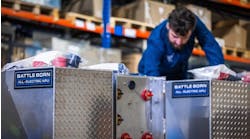Every little bit of efficiency a fleet can squeeze out of engines can go a long way in maintaining a healthy profit margin. Even for fleets that spec the latest in aero kits, low rolling resistant tires and engine technology, or use the most fuel-efficient engine oils, more savings can be had by adding a few ounces of a diesel engine combustion catalyst. These additives accelerate how fast the diesel burns, essentially boosting the engine’s metabolism like a fossil-fuel version of a vitamin-packed smoothie.
“It's literally changing the rate of reaction, which is what catalysts do, and that burns the fuel more thoroughly, and burns it at a faster rate,” explained Michael Traweek, CEO of Internal-Combustion Dynamics, which distributes a catalyst called EnerBurn.
By providing a nano-scale catalytic coating on the chamber surfaces, this catalyst ends up doubling the fuel burn rate and creates more pressure on the crank angle. Basically, this creates more energy out of the same amount of fuel.
And what that does is save fleets money in several ways. EnerBurn, according to manufacturer Enerteck Chemical Corp., improves mileage efficiency by an average of 10%, with a general range between 8 and 15%. Horsepower can also see 4% gains due to the engine digesting more energy from the same amount of fuel.
Saving at the pump may be the most noticeable benefit, and with rising fuel costs, the most critical, but that catalyst also promotes cleaner engine operation, reducing total cost of ownership as well. When used regularly, engine wear can be decreased by 40-50%, according to Enerteck.
The catalyst can be poured into the truck fuel tank directly or mixed into a larger fuel container. For EnerBurn, the fuel to catalyst ration is 2,500:1. For a 150-gallon tank, that’s only a few ounces, Traweek said.
The fuel delivers the catalyst into the engine chamber, where the catalytic conversion takes place during the power stroke. The piston-cylinder becomes more oxygenated allowing fuel to burn quicker and more completely. The end results are a more efficient consumption of released energy and less soot as a byproduct due to lower exhaust temperature.
“By reducing the heat inside the cylinder, then you lower the generation of NOx,” Traweek said. With EnerBurn, customers have found 10% NOx reductions and diesel particulate matter by up to 70%
Traweek noted the diesel particulate filter also benefits from the more efficient combustion and lowering particulate matter: “Putting out less the diesel particulate matter effectively reduces the back pressure on those filters.”
Along with creating less soot and PM, DPF regeneration times are shortened and less diesel exhaust fluid is expended.
“We have run the product for over five months now with no issues, only improvements,” said Paul Sulzberger, a site systems superintendent for a BHP Billiton Mitsubishi Alliance coal mine in Australia, in a testimonial letter regarding EnerBurn. “The fuel savings after the first 800 hours was recorded at an average of 11.67% and over 16% at lower RPM ranges.”
The mine used the product in a CAT V12 C-27 engine with set load ratings during the trial.
Sulzberger noted lower engine noise, clearer exhaust and oil reduction from 3 liters per day to 1 liter over two weeks, due to the carbon being cleared from between the piston rings.
He also acknowledged there was “skepticism from the corporate level” on the catalyst’s efficacy, but he ultimately was allowed to perform the test to prove it out.
According to Traweek, that proving period can last 400-500 engine hours, during which the catalyst slowly conditions the engine.
Similar catalysts have also received positive results from fleets.
Pittsburgh Power’s Max Mileage Fuel Borne Catalyst, which reportedly improves thermal efficiency by 10% and lowers soot emissions by 60%, was found to improve performance in the engine and aftertreatement system as well. In a piece for 10-4 Magazine, Pittsburgh Power founder and owner Bruce Mallinson cited one driver using a Cummins 2015 ISX engine with almost 600,000 miles who improved mpg from 6.5 to 7.5 mpg, while eliminating “hiccups” that were erupting between gear shifts.
“Most likely, it was carbon buildup in the VGT turbo that has now burned off,” Mallinson wrote.
Another user upped his 2014 Peterbilt 579’s MX13 engine efficiency from 6.4 to 7.2 mpg, while DEF efficiency increased from 130 mpg to more than 300 mpg.
Pittsburgh Power forged a partnership with DPF Alternatives, which uses ultrasonic cleaning to restore aftertreatment components, to provide customers who use both the catalyst and cleaning a lifetime warranty on those serviced DPFs.





